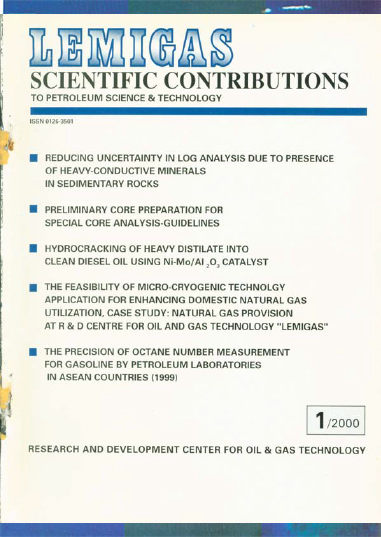HYDROCRAKING OF HEAVY DISTILLATE INTO CLEAN DIESEL OIL USING Ni-Mo/Al2O3 CATALYST
DOI:
https://doi.org/10.29017/SCOG.23.1.1078Keywords:
Hydrocraking, Clean Diesel, CatalystAbstract
Diesel oil is high pollution fuel and the quality of this fuel must he improved to obtain clean diesel oil Crude oil production and its quality tend to decrease. Light fuel oil demand rate is higher than that of residual fuel. Diesel oil produced in the refineries generally consists of predominantly straight-run diesel oil: however, compounds such as thermally and catalytically cracked diesel oils are sometimes included. The quality of straight-run diesel oil, such as hydrocarbon types and sulfur content, will in general reflect the nature of crude oil. Cracked stocks either thermal or catalytic cracked diesel oils, contain higher percentage of aromatic, olefin and sulfur contents and these cracked diesel products must be hydrogenated prior to rounting to final products. The passage of the Clean Air Act Amendment of 1990 in the U.S.A has forced American refineries to install new facilities to comply with stricter specifications for fuels such as gasoline and diesel oil. Hydrocracking processes are a combination of desulfurization and conversion developed primary to process feeds having a high content of unsaturated hydrocarbons (olefin and polycyclic aromatics) and non-hydrocarbon compounds (sulfur and nitrogen compounds) with a bifunctional catalyst. A variety of bifunctional catalysts and processing designs may be used commercially depending on the feedstock used and desired products. Influence of both feedstock compositions (paraffinic and non-paraffinic vacuum distillate, and wax) and the acidity of bifunctional catalysts on the performance of hydrocracked diesel oil products are discussed briefly in this paper. Low yield or selectivity of diesel oil products by high catalyst acidity, it is suggested that the higher secondary splitting has taken place in converting cracked products into large amounts of low-molecular weight hydrocarbons such as gasoline and LPG. High diesel index product of the paraffinic feedstock due to the high paraffin content of the produced diesel oil.References
John R. Dosher and Jack T. Carney, 1994, "Sulfur Increases Seen Mostly in Heavy
Fractions of Lower Quality Crudes". Oil and Gas Journal, May 23, pp. 43-48.
Robert J. Beck, 1996, "Oil Supply Increases Due in 1996's Second Half, Oil and Gas
Journal, July 29. pp. 57-76.
B.H. Cooper, A. Stanislaus and P.N. Hannerup. 1993, "Hydrotreating Catalysts for
Diesel Aromatics Saturation", Hydrocarbon Processing, June, pp 83-87.
A.S. Nasution and E. Jasjfi, 1997, "Gas Oil Components From ASEAN Refineries and
the Effect of the Changing Gas Oil Quality Requirement", Presented Paper at
ð‘¡â„ŽASCOPE Laboratory Workshop. Penang. Malaysia, May.
News, 1993, "New Diesel Rule Litmus Test for California Refineries Regulations", Oil
and Gas Journal, August 30, pp. 21-26.
Frederick L. Potter, "Europe Moves Closer to Final Clean Fuel Vehicle Plan". Hart's
Fuel Technology & Management, pp. 1.
A.S Nasution, 1984, "Influence of the Catalyst Acidity on the Hydrocracking of
Vacuum Distillate into Middle Distillate", Presented Paper at the 8
ð‘¡â„Ž
International
Congress on Catalysis, West Berlin, West Germany, July.
A. S. Nasution, 1985, "Hydrocracking of Vacuum Distillate for Middle Distillate
Production", Presented Paper at the 5
ð‘¡â„Ž
International Seminar on Developments in
Engine Oils, Industrial Oil, Fuels and Additives, Mist Petroleum Co, Cairo, Egypt.
October.
J.F. Le Page, 1987, "Production of Lube-Oil Blending Stocks Through Hydrotreating".
Applicd Heterogenous Catalyst, Edition Techniq, Paris, pp. 435-467.
Lawrence Wisdom, Eric Peer, and Pierre Bonifay, "Resid Hydrocracking Better
Than Delayed Coking in Case Studies". Trand Gas Journal. Feb. T6,-pp. 53-60.
NN, 1988, "The Shell Residue Hydroconversion Technology Development and
Achievements", Hydrocarbon ASIA, May/June pp 52-60.
Lawrence Wisdom, Eric Peer and Pierre Bonnifay. 1998, "Cleaner Fuels Shift
Refineries to Increased Resid Hydroprocessing". Oil and Gas Journal. Feb. 9, pp. 58-
A. S Nasution, 1985, "Influence of the Particle Size of Catalyst on the Hydrocracking
of Vacuum Distillate into Middle Distillate and Lubricant Base Stock". Presented
Paper at 14
ð‘¡â„Ž 1PA, Jakarta, October.
NN, 1998, "H-Oil Versus Coking for the Tum of the Century", Hydrocarbon Asia,
March, pp. 32-41
Downloads
Issue
Section
License
Copyright (c) 1970 SCIENTIFIC CONTRIBUTIONS OIL AND GAS (SCOG)

This work is licensed under a Creative Commons Attribution 4.0 International License.
Authors are free to Share — copy and redistribute the material in any medium or format for any purpose, even commercially Adapt — remix, transform, and build upon the material for any purpose, even commercially.
The licensor cannot revoke these freedoms as long as you follow the license terms, under the following terms Attribution — You must give appropriate credit , provide a link to the license, and indicate if changes were made . You may do so in any reasonable manner, but not in any way that suggests the licensor endorses you or your use.
No additional restrictions — You may not apply legal terms or technological measures that legally restrict others from doing anything the license permits.














